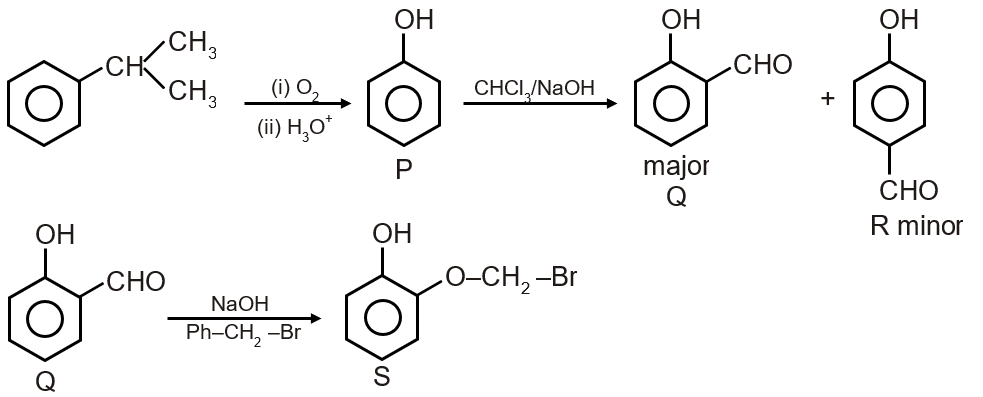The correct statement(s) about the following reaction sequence is(are)


S gives yellow precipitate with 2,4–dinitrophyenyl hydrazine.
Q give dark violet coloration with 1% aqueous FeCl3 solution.
This reaction sequence involves organic transformations where we need to analyze the products and their chemical properties. Let's break it down step by step.
The starting compound is cumene (isopropylbenzene). The first reaction is oxidation with KMnO4/KOH, which is a standard method for oxidizing alkyl side chains on aromatic rings to carboxylic acids. The isopropyl group (-CH(CH3)2) gets oxidized to a carboxylic acid group (-COOH).
So, cumene (C6H5CH(CH3)2) is oxidized to benzoic acid (C6H5COOH). Therefore, compound P is benzoic acid.
Benzoic acid (P) reacts with SOCl2 (thionyl chloride) to form an acid chloride. This is a common method to convert carboxylic acids to more reactive derivatives. The acid chloride then reacts with phenol in the presence of NaOH to form an ester. Phenol is activated by NaOH to form phenoxide ion, which is a good nucleophile for ester formation.
So, the product Q is phenyl benzoate (C6H5COOC6H5).
Phenyl benzoate (Q) undergoes Fries rearrangement with AlCl3. This is a Lewis acid-catalyzed reaction that rearranges phenolic esters to ortho- and para-hydroxy ketones. Since the ortho position is sterically hindered, the para product is major.
So, the product R is 4-hydroxybenzophenone (p-hydroxybenzophenone).
4-Hydroxybenzophenone (R) is reduced with LiAlH4, which reduces carbonyl groups to alcohols. So, the ketone group (-CO-) is reduced to a secondary alcohol (-CH(OH)-).
The product S is 4-(hydroxy(phenyl)methyl)phenol, which is a benzhydrol derivative with a phenolic -OH group.
Option 1: S gives dark violet coloration with 1% aqueous FeCl3 solution.
FeCl3 test is used for phenols. S has a phenolic -OH group, so it should give a positive test (violet coloration). This is correct.
Option 2: R is steam volatile.
R is 4-hydroxybenzophenone. It has an intramolecular hydrogen bond between the carbonyl oxygen and the phenolic hydrogen, making it less volatile. Phenol is steam volatile due to intermolecular H-bonding, but here the intramolecular H-bonding reduces volatility. So, R is not steam volatile. This is incorrect.
Option 3: Q gives dark violet coloration with 1% aqueous FeCl3 solution.
Q is phenyl benzoate, which is an ester. It does not have a free phenolic -OH group (it's esterified), so it will not give a positive FeCl3 test. This is incorrect.
Option 4: S gives yellow precipitate with 2,4-dinitrophenylhydrazine.
2,4-DNPH test is for carbonyl compounds (aldehydes and ketones). S is an alcohol (reduced product) and does not have a carbonyl group, so it should not give a positive test. This is incorrect.
Only option 1 is correct.
Related Topics: Oxidation of alkylbenzenes, Esterification, Fries rearrangement, Reduction of carbonyls, Qualitative tests for functional groups (FeCl3 for phenols, 2,4-DNPH for carbonyls).
Key Reactions:
- Oxidation: (with KMnO4/KOH)
- Esterification: (via acid chloride)
- Fries Rearrangement: Phenolic ester to hydroxy ketone with AlCl3
- Reduction: with LiAlH4